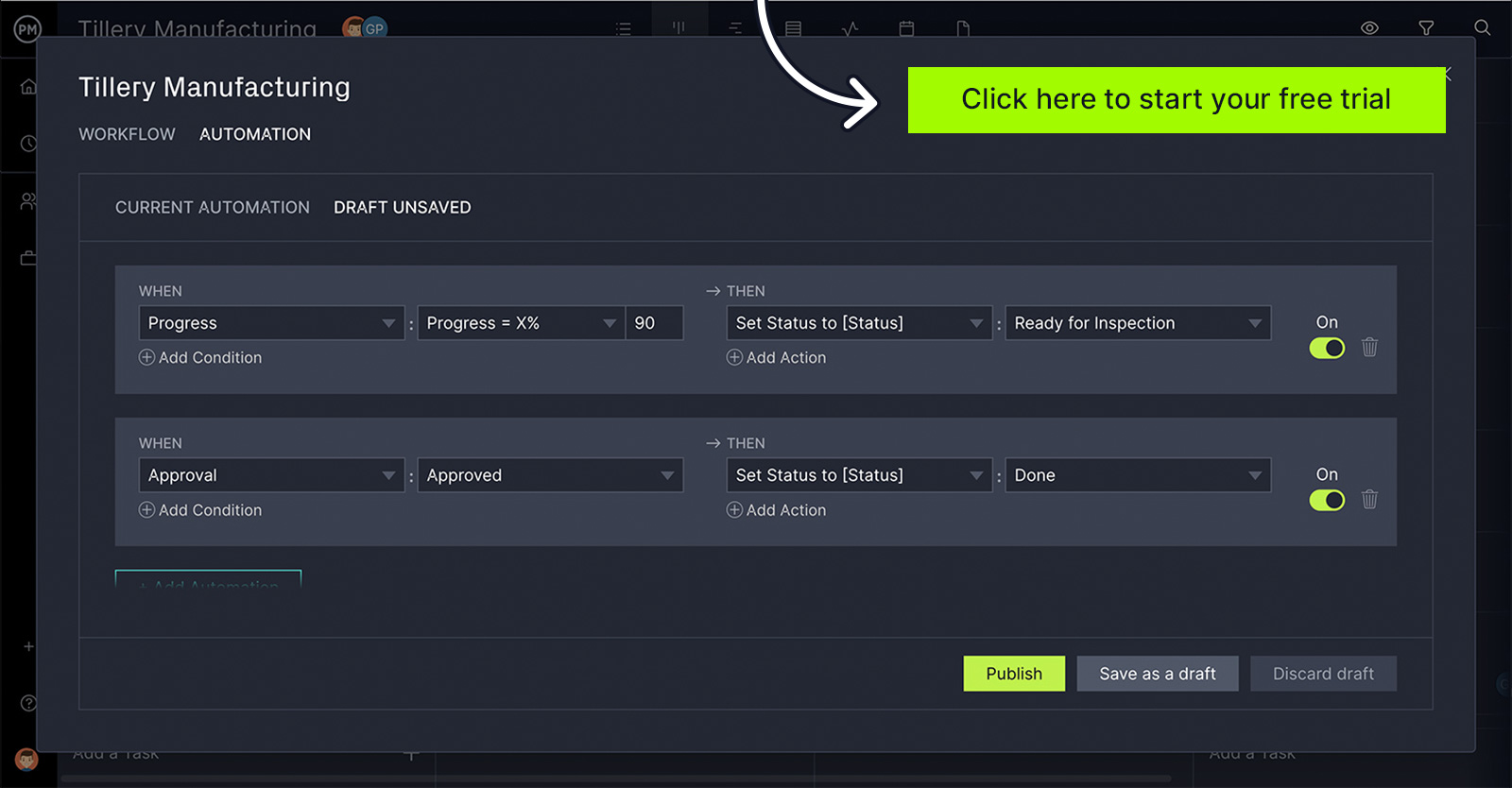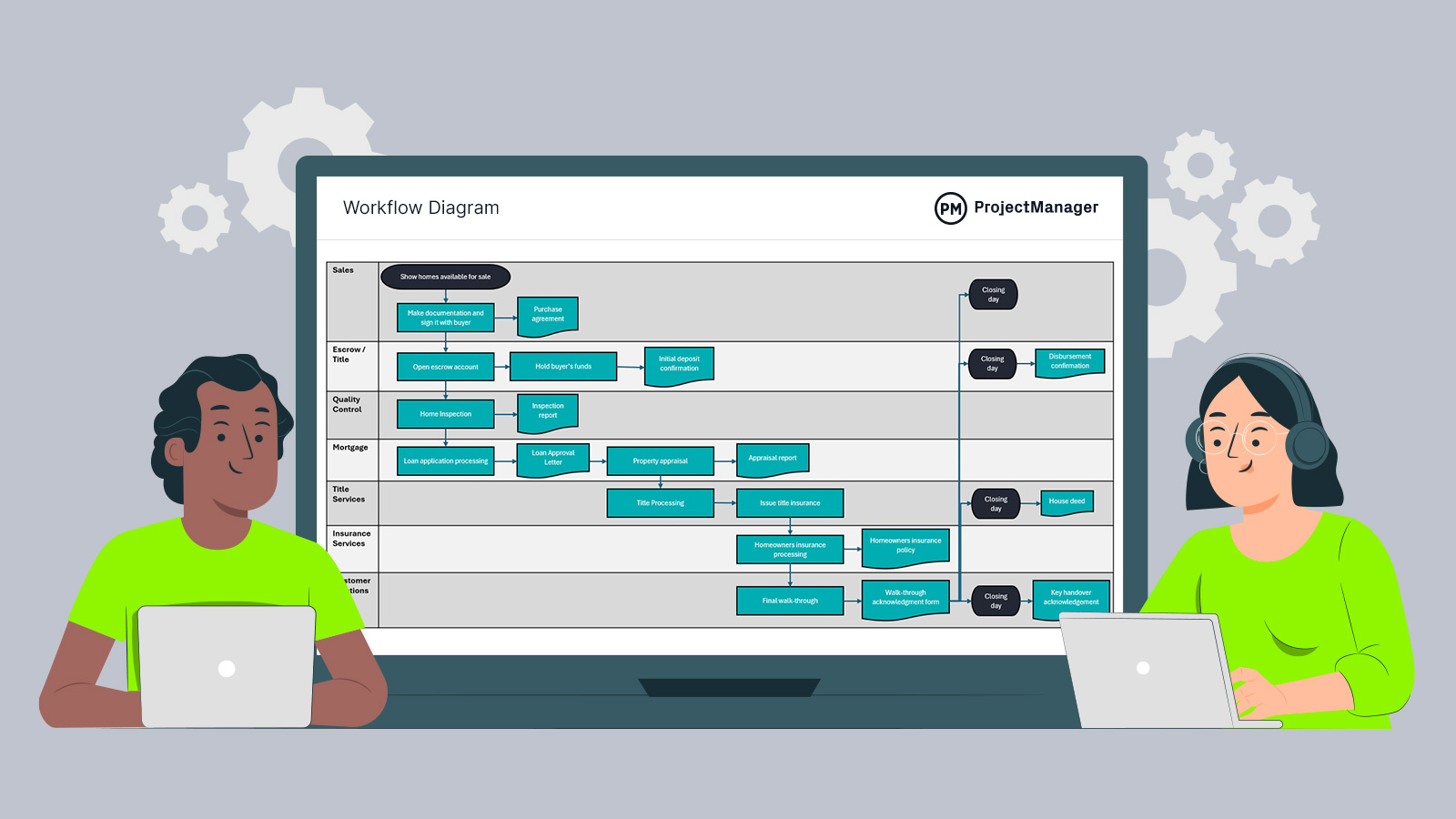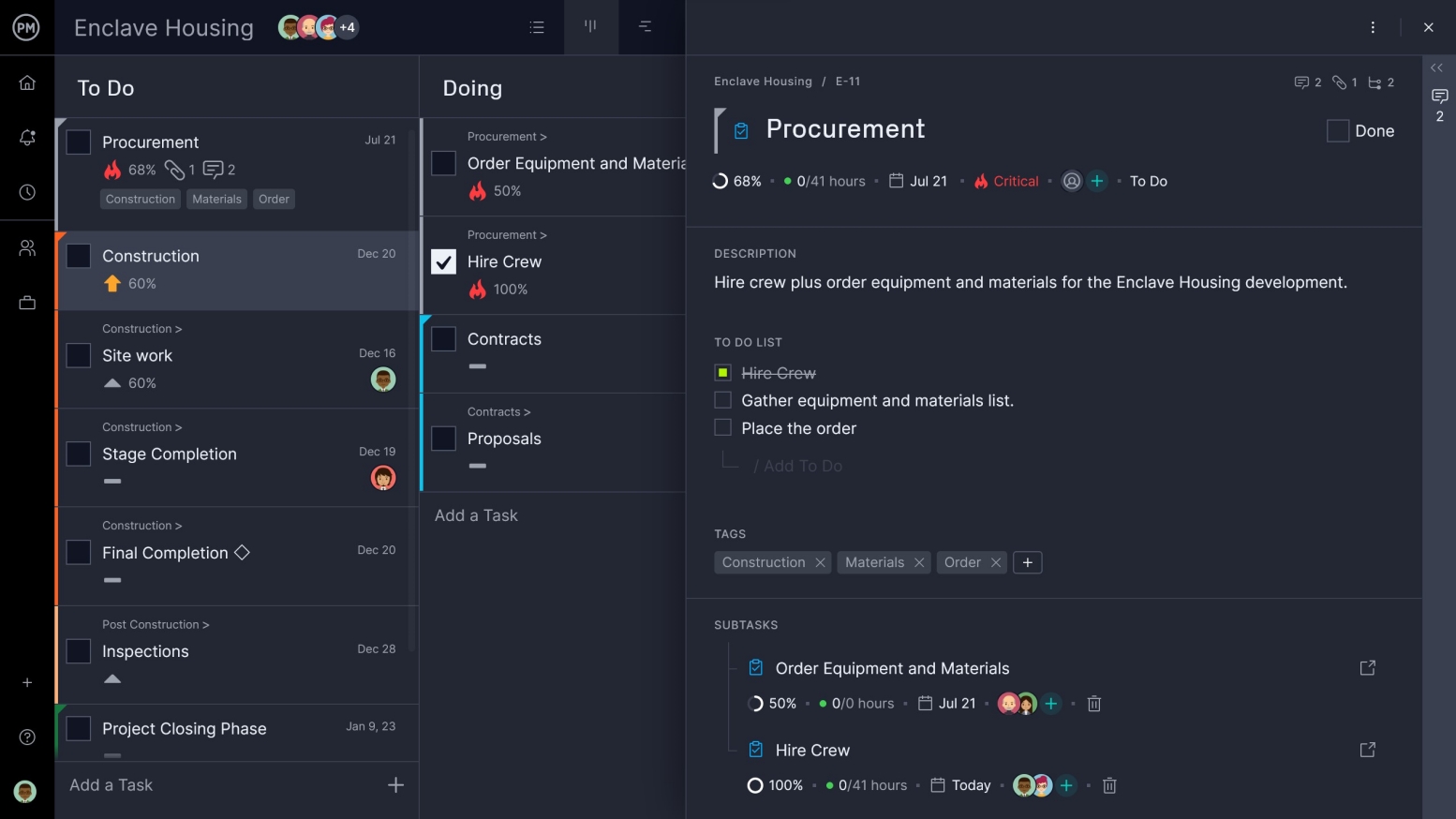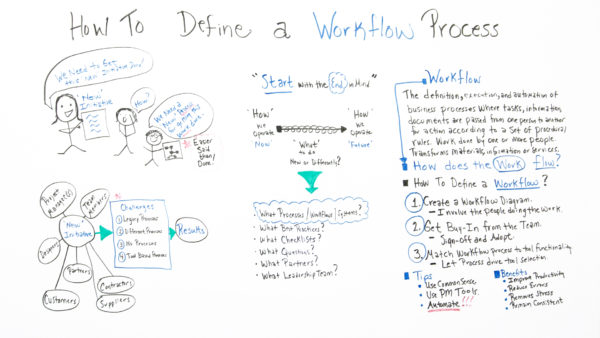Wondering how you’re going to get that project done? First, you need to define a workflow process. Read below to learn how.
What Is a Workflow Process?
Workflow is the process of defining, executing and automating business processes where tasks, information and documents are passed from one person to another for action according to a set of business process management rules. It involves work by one or more people and transforms materials, information or services.
Project management software allows for seamless workflow automation. ProjectManager is work and project management software with custom workflows and task approvals to add efficiency while maintaining quality. Set as many triggers as you need for each process and coordinate actions to change status, priority, assignee and more. By using task approvals, you choose who has the authority to make those changes to control the process. Get started for free today.

Workflow Process vs. Business Process
Workflow processes and business processes are related but they’re not one and the same. A workflow process is the automation of a business process that can be fully automated or simply part of the automated process. The process can include documents, information or tasks that move through the process according to a set of procedural rules.
A business process, however, is a set of one or more linked procedures or activities that together help you realize a business objective or policy goal. This is usually within the context of an organizational structure that defines roles and relationships. You can think of it as a process that’s applicable to another process.
In short, a business process is related to an activity that can be manual or automated and it realizes a business objective. A workflow process is a business process that is either fully or partially automated. It represents an approach and technology for automating tasks in a business context. A business process is more generic and usually involves a complicated flow of automated and manual tasks.

Get your free
Workflow Diagram Template
Use this free Workflow Diagram Template for Excel to manage your projects better.
Start With the End in Mind
When you’re first thinking about a workflow, you want to start with the end in mind. This means you shuold look towards the end goal and then work backward so you can figure out the right path to get there. This will help you determine your workflow process.
From this perspective, you’ll want to ask yourself some questions, such as: what are the processes, workflows and systems needed to reach the endpoint in the project, and what are the best practices to employ? You’ll want to create a checklist and ask questions. Note who you’ll partner with and decide what leadership team will drive the whole endeavor.
How to Define Your Workflow
Defining a workflow for your project is the cornerstone of work management. Here are three tips to do it right:
- Create a realistic workflow diagram, and involve the people doing the work.
- Get buy-in from the team, have them sign off, and then adopt the plan for the project.
- Match workflow process to a tool functionality so that the process drives the tool selection, and not the other way around.
There are many benefits of following this course. It will improve your productivity, reduce errors as you’re working on the project, help relieve stress and keep you consistent.
Workflow Process Automation
Once you’ve defined your workflow, you’ll want to make it more efficient. One way to do this is through workflow automation. It helps to streamline the internal workflow by getting rid of much of the manual data entry and request handling.
Automation will also allow you to track the status of tasks, such as if they’re completed, pending or in progress. If your software is cloud-based like ProjectManager, then those status updates are recorded in real-time, adding further efficiencies.
Software with automation features can also help teams stay on task. When the status is late or a deadline is looming, an automated notification can be emailed to the team member responsible for that task. Just as important, when the task is completed, the team is notified, helping to smooth the transition from one task to another.
Free Templates to Help With Workflow Process
The workflow process involves automation and for that to work you need software. But not everyone is ready for that upgrade quite yet. If you’re still on the fence, then we have free project management templates that can help with your workflow process. Here are a few of the dozens that ProjectManager offers for free on our site.
RACI Matrix Template
Before you can create a workflow process you need to understand who is doing what on your team. That team organization is done with the help of our free RACI matrix template for Excel. You can use the free template to collect team members under categories that correspond to the acronym: responsible, accountable, consulted and informed.
Work Order Template
If your workflow process involves people outside of your organization, you’ll need our free work order template for Excel. It covers labor, tools and materials that are needed to complete the work with instructions on what has to be done, how much it’ll cost, the deadline to finish the work and who is assigned what tasks.
Agile Sprint Plan Template
Teams may not work the same way that managers plan which is why you need to speak their language. If you’re working in an agile environment, use our free agile sprint plan template. It gives your team agile’s inherent flexibility with its short, iterative sprints that last only a couple of weeks.
How ProjectManager Improves Workflow Process
ProjectManager is project management software that automates much of the manual labor to make your workflow more productive. Our software alerts assigned team members when deadlines are approaching, making sure that everyone is aware of the schedule and keeps the project on track.
Create Workflows on Kanban Boards
We have features that add efficiencies to workflow such as kanban boards that visualize the workflow. Like a traditional kanban board, you can have three columns: to do, doing and done. Under each of these are cards are the individual tasks that can be assigned to team members. These cards can be tagged for easy filtering and comments and documents can be added for better collaboration.
Cards can be expanded to show even more detail about the task. The expanded view shows hours worked, you can create a to-do list and much more. If you want to pull in another team member who isn’t assigned to the task, just tag them and they’ll be notified by email.

Track Progress on Dashboards
The workflow must be analyzed to optimize it, another area in which ProjectManager can help. You can see how your project is progressing in real-time with our project dashboard. It tracks all your tasks in one view, showing you the percentage complete. You can also view your team’s workflow and monitor their progress.

ProjectManager has the tools to do this and so much more when planning, tracking and reporting on your project. See how it can help with your workflow and more by taking this free 30-day trial today.
Watch this Video to Learn More About Workflow Process
ProjectManager has tutorial videos to expand on our large library of blog posts on every aspect of project management. In this short training video Jennifer Bridges, PMP, defines what a workflow process is.
Here’s a screenshot for your reference!

Thanks for watching!
Transcription:
Today we’re talking about how to define a workflow process. Well, often when you manage a new initiative or new project you have to define a new process for getting the work done.
Well, that’s easier said than done sometimes. If you look at a new initiative or new project there are multiple players involved so you may have a project manager or multiple project managers, you have different team members, many times you have designers, partners, customers, contractors, and even suppliers.
And with that, some of the challenges that occur are you’re dealing with legacy processes, maybe things that were done in the past, so sometimes people kind of hold on to the way it used to be. And then you had different processes so especially if these are third parties or maybe vendors, they have their own process.
So trying to get everybody talking in the same language or doing things the same way is difficult. And then sometimes some of these players have no processes at all, and then some people have their processes designed according to the tool which makes it difficult at times to get the results.
So when we’re designing a workflow process we wanna start with the end in mind. So what does that mean? We take a look at how we operate now versus how we wanna operate in the future. And so we need to look at, what do we need to do new or differently?
So some of the things we wanna look at are defining what the processes, workflows, and systems look like, best practices, checklist, what questions do we need to be asking, what partners do we need to have on board, and what does our leadership team need to look like. But today, in today’s whiteboard session, I wanna focus on the workflow.
So let’s start by looking at what a workflow really is. It’s the definition, execution, and automation of business processes where tasks, information, and documents are passed from one person to another according to a set of procedural rules. And the work can be done by one or more people and it transforms materials, information, or services. Basically, we’re looking at how does the workflow?
So let’s talk about how we define one. So this is at a very high level, but the three main steps are, first of all, to create a workflow diagram. So it’s literally a diagram of how that work passes from one person to another, or from one group to another. And, of course, you can imagine that can get at a very detailed level. But the important thing to remember is to involve the people who are doing the work so it’s realistic.
And then second of all, once you get the diagram completed you want to socialize that with the entire team and make sure there’s buy-in, make sure there are no gaps, and make sure, again, it’s realistic. You want everyone to sign off on the process and adopt it and implement it across the project or initiative.
And then on the third one, match the workflow process to tool functionality. Here, we want to let the process drive the tool. But again, sometimes people say, “Well, that’s not in the real world,” because a lot of times that tool is selected by or already used by a corporation. But with that, we wanna use common sense.
We also want…you can see how important project management tools are. And with that by using the tools we wanna automate as much as possible. So, therefore, the people doing the work can do what they do best and that’s the work. And then…so what’re the benefits of all of this? It really improves productivity, reduces errors, removes stress and keeps things consistent among the initiative or the project.
So if you need a tool that can help you with your workflow process then sign up for our software now at ProjectManager.

